If you have never raised rabbits for meat, here is your no-BS primer. Instead of starting at the beginning of raising rabbits, where most stories start, I will start at the end. The goal for a meat rabbit is to end up in a pot or a pan feeding people. Rabbits can be braised, baked, fried, stewed, fricasseed, sweet and soured, BBQed, smoked, roasted, glazed and covered in pineapple slices, or canned. You can even make them into pot pies.
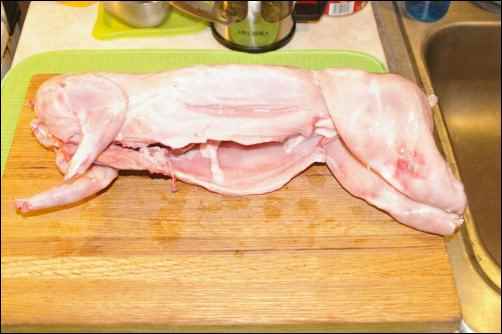
The best eating rabbit is tender and not tough. It is plump. And it is cooked appropriately for the cut. The goal is to raise tender, plump dinner… not cute, fluffy “bunnies.” Although all bunnies are cute and fluffy by nature.
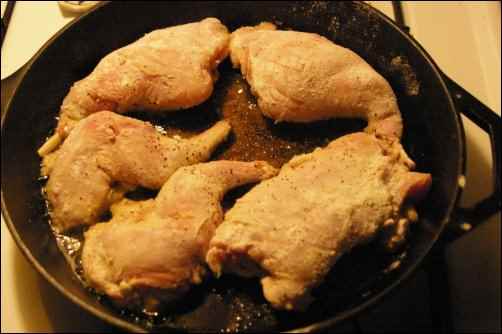
Again, working from the end to the beginning. Before you cook a rabbit, the meat needs to rest in a cool place for at least three days after slaughter. When I slaughter rabbits I put them in a cooler full of ice for 60-72 hours. This also removes all the blood, making a nice clean carcass.
I only freeze, cook, or otherwise process a rabbit after three days of resting the meat. This allows for the stresses of rigor mortis to pass. Right after you clean a rabbit they are very pliable. However, before too long they become very stiff. This is caused by the chemicals and proteins in the muscles being deprived of oxygen (because the blood stopped supplying them). Resting the meat allows this to pass.
I generally cut my rabbits down into two back legs (I call them “legs”), two front legs (I call them “wings” because they are smaller), two tenderloin cuts (each side of the spine I call “tenders”), and the two belly flaps (I call “bacon”). I generally freeze similar cuts together in meal-sized portions if I’m processing multiple rabbits.
Before you eat it you must age it. Before you age it you must slaughter it.
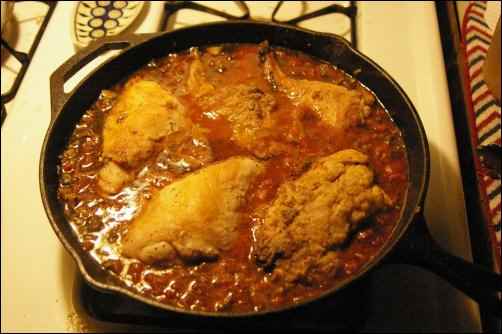
In order to reach our goal of tender and plump rabbit we must slaughter a rabbit when it is young. How young? A two-week-old rabbit would be very tender indeed… however, it would also be very small. So we want to find the right balance of young and plump. The proper age is 10-12 weeks. The right kind of meat-rabbit will grow very rapidly until week ten. It will also grow very rapidly compared to the amount of food it eats. After week ten, the rabbit eats more and grows much more slowly. So week ten is the optimal time to slaughter a rabbit.
The reason people raise California and New Zealand rabbits for meat is that they are very good at growing to five pounds in 10-11 weeks. If you are growing rabbits and they only grow to three or four pounds in 10-12 weeks, then you should cull the breeding stock and replace it with better stock.
If I had ten great does, instead of ten dud does, and each had thirty babies per year, but each baby grew to five pounds in ten weeks, how much rabbit meat would I have made? I would have made 1,500 pounds of pre-slughter rabbit meat per year. That’s 50% MORE MEAT for exactly the SAME WORK.
Slower growing rabbits not only require more feed to reach slaughter weight, they also require more cages.
The logic is simple, if it takes longer for the babies to grow to slaughter-weight, then I either need MORE grow-out cages (which require more space, more watering bottles, more feeders, and more food) or I need to have LESS babies. If, on the other hand, I spent the time and money necessary to have great breeding stock with babies that grow out in 10 weeks instead of 12 weeks, then I can grow more rabbit meat, in less time, in less space, and with less cost. That’s why good breeding-stock pays for itself over time.
Slaughtering Rabbits
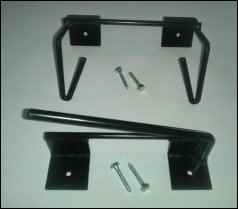
I use the “Hopper Popper” to slaughter rabbits. It is two devices. The first device (bottom of picture) is an angled piece of metal that you slip the rabbits head into (head on top, body on bottom). Then you slide the rabbit over to the narrow side (right) and you pull hard on its feet. This dislocates the rabbit’s neck. The rabbit’s body will jerk for about 20 seconds afterward, but this is just what it does.
The second device is made to hold the rabbit’s back feet (belly toward you) so you can skin and gut the rabbit. As soon as possible, I transfer the rabbit to the foot hooks and cut off it’s head. I put a 5-gallon bucket under the gutting station to catch all the debris. I like to wet the rabbit down with the hose after it’s dead. This makes it easier to keep the fur from getting on the meat. After you remove the head, you continue skinning and gutting. Youtube videos are pretty clear on this step.
Slaughtering is an essential part of growing meat rabbits. It’s really the entire point. Yesterday, I slaughtered and cleaned twenty rabbits. It took four hours. It’s not my favorite job, but it’s necessary for a homesteader who raises rabbits for meat.
What are you going to do with the guts, heads, and skins? Some people tan the skins, but on a ten-week-old rabbit, they are pretty thin and the fur is poorly developed. I generally put the waste out in a corner of my field for the birds, and other critters, to eat.
The Rabbit Cages
All the rabbits I slaughter come from “grow” cages. These are cages that are about 24″x24″ and each cage holds four rabbits. I do this because I use 1.5-pound feeders. Near the end, when they are big, 6 or more rabbits will empty a 1.5-pound feeder in a day. I like for my growing meat-rabbits to never run out of food. So I grow them four rabbits per cage. Hence smaller cages with four rabbits each. My breeding moms are each kept in a large 36”x36” cage and are fed careful portions to control their weight. Breeding does must not be allowed to get fat; it affects their production. The larger cage allows them to keep the babies with them for the first six weeks.
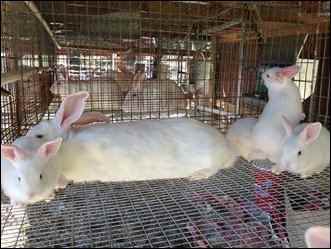
I keep two breeding bucks. One is the primary breeder, the other is the backup breeder. They can be kept in smaller cages than the does, because they will have no visitors. Always bring the doe to the buck’s cage for breeding – never the other way around. Watch them breed. I generally want the buck to successfully mount the doe twice; this normally takes less than 10 minutes, then I remove the doe. I try to breed the buck to the doe in the morning then again in the afternoon on the same day. This ensures impregnation.
I split my rabbits into two “doe groups,” I impregnate all the does from Group 1 during the same week. Then three weeks later I impregnate all the does from Group 2. This means that I only need enough grow-out cages for one group at a time. I move rabbits to grow-out cages at six weeks.
Why don’t I just leave the babies with their mother a little longer? Because I do continuous breeding. I will breed a doe just two weeks after they give birth to a litter. That means that the doe is pregnant again while she is still nursing. If I don’t take the babies out at week six, then she the mom will not have enough energy to make the new litter. Breeding does again two weeks after they give birth is a standard meat-rabbit procedure.
Finally, you will only breed a doe for 12-18 months before you replace her with a younger doe. Bucks get replaced as well. The faster you choose better and better stock to replace your old stock the faster your rabbit operation improves in quality, quantity, and efficiency. These “replacements” need cages as well. Before breeding age it’s okay to keep rabbits together. Since I want to be growing out 12-15 replacements I need 4-5 cages. I also keep a quarantine cage in case I need to separate a rabbit from the rabbitry due to illness.
So, my rule of thumb for a ten doe operation is 25 – 30 cages:
- 10 doe cages 36″ x 36″ (row 1)
- 2 buck cages 30″ x 30″ or larger
- 8 to 12 grow out cages 24″ x 24″
- 4-5 replacement stock cages 30″ x 30″ or larger
- 1 quarantine cage 24″ x 24″
Buying used cages can be a great deal. I purchased a high-quality ten-cage “gang” of cages for $100, which is an excellent deal. Craigslist is good, the local small-animal auction is better. Find one near you.
Rabbit Housing

24′ long x 20′ wide building:
- Row 1 = 7 doe cages
- Row 2 = 3 doe cages, 2 buck cages, and 2 replacement cages
- Row 3 = 3 replacement cages, 6 grow-out cages
- Row 4 = 6 grow-out cages, 1 quarantine cage, plus 84″ wide feed storage area.
This leaves two walking rows between cages that are 4-5′ wide and a 3-5′ area on the end to walk from row to row. It’s best to have all the doe and buck cages facing each other for easy transfer of does. I also put my bucks in the center of the row, so I don’t have to walk a doe very far to put her in.
This building assumes all other activities (such as slaughter) will be done somewhere else. Dirt floors are best. The walkways can be concrete (expensive but nice), gravel, or concrete blocks.
I prefer using watering nipples and tubing that runs from cage to cage; watering rabbits by hand is a huge pain. I use standard 1.5-pound feeders in each cage. You need to provide adequate ventilation; summer heat is hard on rabbits. Winter cold isn’t hard on them if you keep drafts down and keep them dry.
Starting Small
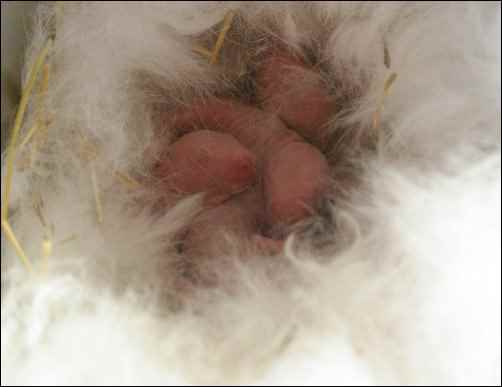
Even though I say you should have the best stock possible, it’s okay to start with sub-standard stock. It’s good practice, it keeps costs low and some mistakes will be made that cause rabbits to die. So it’s okay to start with cheap rabbits in order to learn the procedures. Just make sure they are healthy and free of disease.
A simple four-cage backyard rabbit system is a good place to start. One buck and two does, with one grow-out cage. You stagger the mating of the does by three weeks and wean the kits at six weeks. If your kits grow more slowly and need more time, then you can just add a fifth cage.
It’s not too hard to get 30 babies (kits) out of a doe each year. So this setup would create 60 meat rabbits per year… That’s one per week plus replacement stock. Not a bad way to make food! This will give you one rabbit dinner per week from just three rabbits. Not bad!
Why Raise Meat Rabbits?
I love breeding rabbits, keeping rabbits, processing rabbits, and eating rabbits. I like being able to make my own food. If I can make some money doing it then, all the better.
Plus, even though I’m going to eat them… they’re still cute!











I was always told to NEVER put the buck into the doe’s cage for breeding as the doe is territorial and will castrate the male. Sadly, a friend of mine did this and ended up losing several males because the females had castrated them and then killed them. Because of that, I have Always put my does into the buck’s cage for breeding which has always worked in my favor. I have been successfully breeding and raising meat rabbits for 3 years now.
That’s correct. There was a mis-written version of this article that says to bring the buck to the does cage, but that is the wrong version. I have asked to post the version that says to bring the doe to the buck’s cage for this article. It’s very important to do that. Thank you for your comment. You are 100% correct.
Thanks, Jessica and Tony. I’ve corrected the article again. I don’t know why WordPress keeps reverting it, but another commenter on the previous version mentioned having the same issue on their own website. I’ll keep my eyes on it.
Hi Tony,
Thanks for the article, it’ll be one that I add to my research archives as I look into what it will take to raise my own rabbits. Looking at your posts, I can see that you have gone from omnivore, to herbivore, and then back to omnivore and it looks like you are raising rabbits once again. How difficult did you find it to source your stock as you were starting back up?
The reason I ask is because I am a total city kid. I never got to participate in 4H and the biggest plot of land I have ever lived on is 0.6 acres. I am really excited to start my rabbit trio in May and there is tons of information out there on how to breed, raise, and process rabbits, but not a lot on where to find good starting stock. A lot of the rabbitries that come across look great because they have kept health and quality in mind, but they are always geared towards meat pen show rabbits and sell them for a minimum of $50 each. That seems steep to me, please correct me if I am wrong.
If you have any tips for me on sourcing my trio, I would appreciate it!
Elisa
sorry about the delay in responding. Look up my article on this site about the “small animal auction.” It’s a good place to buy stock for the proper market rate. I have bought “show quality” rabbits for $35+ each. I found that they had good body composition but some of them weren’t great at breeding. They would no allow the buck to mount or they would not raise their babies correctly. That means they might not pull full to make a nest in the nesting box or they might just have their babies on the wire floor of the crate. This pretty much always means the babies won’t survive.
So read that article and call around to feed and seed stores “in the country” to find one that’s an hour or two away from you. The people who advertise to city folks are good at charging premium prices. I’ve seen rabbits go at the animal auction for as little as $5 each. Plus there are often people there selling cages, waterers and the like. It’s often possible to buy rabbits and the cage they are in from someone who is getting out of the rabbit game for a while.
You can find meat rabbits for sale on our Meat Rabbit Breeder Directory. Search by breed or state. Good luck in your search! https://breeders.homesteadrabbits.com/
I am new to raising rabbits for meat but have raised rabbits before. My question is this if you wait until they are more than 5 pounds when you cull them do you run into problems or is there a reason that you cull at 5 pounds any help would be greatly appreciated.
The older the rabbit the tougher the meat. What that means in real terms is a trial and error sort of thing. But generally I’m doing constant breeding, so I need the space for the next litter. I’m fairly disorganized so my slaughtering typically comes when I need the space, not at an exact time or weight.
Hi,
I live in northwest Ohio and I’m considering raising rabbits for meat. I have a few hens for eggs and I see this as the next stage to our homesteading. The question I have is I’m having a challenge locating a place to get the rabbits if you have any suggestions that would be appreciated.
Thank you
Do you split your does into groups of 5? Then expect 30- 40 babies at a time?
If I were more organized I might. What happens is that some rabbits, even after I think they are bred aren’t really pregnant. Some people “palpate” the doe at a certain point in gestation to see if they can feel the babies inside. I never got a hang of that, so I just put in a cage at 28 days and see if they have babies or not. That means that out of 5 does I might have 3-4 litters. THAT means that I’m often breeding does on a staggered schedule, because if a rabbit does not have kits then I rebreed immediately, but if they DO have kits then I rebreed after 2 weeks. This makes for a chaotic system. I use a rabbit breeding program to track all of this. The one I use is Evans Rabbit Registry Deluxe. Here’s my review of it: https://tonybluegoat.blogspot.com/2015/04/evans-software-rabbit-registry-deluxe.html
We are moving to South Texas, near Corpus Christi next year and I was considering raising rabbits for meat. You mention the summer heat is hard on rabbits. Does that mean I need to use a climate controlled building? Or just a lot of shade and maybe fans to maintain a breeze?
I’m in west Phoenix. While I do have AC in my Rabbit shed, I only breed in “winter”. I consider July August September to be the rabbits winter because of our heat. I’m like you, a bit disorganized, starting to clear space, ie harvesting. Expect to start breeding this month. I appear to be the only one in my area that has meat rabbits. Overtime I’ve developed a private list of people wanting to buy.
You discuss replacing your breeders every 12-18 months. I assume the replacement does come from your litters, but what about the replacement bucks? Do they come from an outside source or is it ok to inbreed meat rabbits?
yes ok to inbreed.. cull the undesirables. Save the biggest for future breeding stock.
At what age do you replace your bucks? I can see replacing your does yearly to year and a half as breeding and raising young takes a toll on their bodies, but what about the bucks?
I am starting my journey http://www.ontariorabbits.com and I’m writing of my journey and compiling all of my research. I’m really like oking forward to this chapter in my life.
What do you do with your retired does?
I’ve kept them in the past. NO more room. I may live in “Farm Country” but we in AZ do not have a Dr. Pol. My last doe, very tired, ready to go was turned away from a “PET” Vet. I now put them on grass in a dog pen. This was so new, she had lived her life in a cage so this was a very new experience. Then I used a pump .22. Now I’ll be processing for meat, so I don’t waste her. I used to put them down and keep fur and all for a friend’s dog food. If I process, could find a friend locally for the dog food angle. As my Am Chin breeders are large, and probably tough, could do it that way, as long as I track them after process. I will say, currently have no empty cages, and need to start processing. Will start very early, because of our heat.
I’ve always heard that you shouldn’t eat rabbits before the first frost because of parasites. Does that apply to rabbits raised for meat as well or is it strictly for wild rabbits? I’ve been searching and searching online and can only find information regarding wild rabbits. No sites I’ve been through mention if rabbits I raise for meat are safe or not.